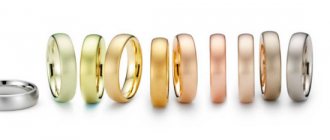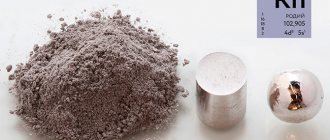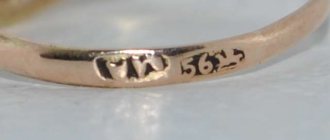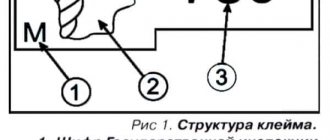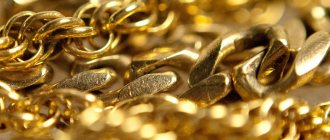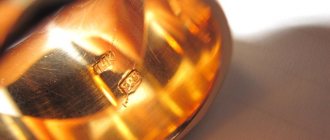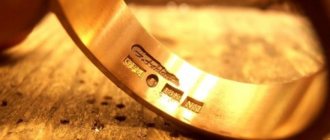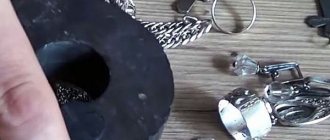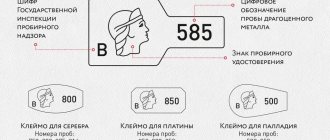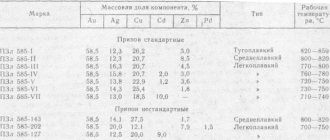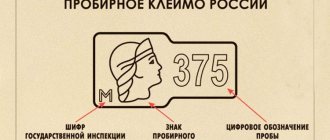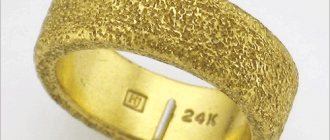State hallmark
A heart in Stas Mikhailov’s repertoire is made of pure gold (and then only as a metaphor), but not a precious coin or a piece of jewelry. Gold and silver items are durable and strong only because they are made from alloys. True, the share of silver or gold in them often exceeds 95%. The content of precious metal in products is called breakdown. It is designated by a three-digit number, since it expresses the mass in 1000 parts of the alloy. Control over the sample is the prerogative of the state. All jewelry sold or sold in Russia - whether domestically produced or imported - is marked with an hallmark. Marking is not placed on:
- coins that have been issued;
- nuggets used in “jewelry”;
- state awards;
- gold and silver leaf;
- small cuts with precious metal on boxes, vases and other valuable items.
In Russia, a certain list of jewelry samples is valid:
- 375, 500, 583, 750 and 958 – for gold;
- 750, 800, 875, 916, 925 and 960 – silver;
- 950 – platinum;
- 500 and 850 – palladium.
The metal content must correspond to the regulated values; its share in the product cannot be less than the applied sample. In an imported product it may be slightly larger. Testing and marking are carried out by state testing inspections.
Question No. 3. “How many samples can there be on a piece of jewelry?”
If you come across a piece of jewelry that has less than 4 marks on it, it’s either a fake or you should look for better marks. According to international law, all jewelry made of gold , silver , platinum and palladium , as well as any alloys with them, which contain more than 30% of the precious metal, must have at least four hallmarks.
The first (geometric) designates the type of metal (rectangular hallmark for gold, rectangular hallmark with rounded sides for silver, octagonal hallmark for platinum and elongated hallmark with a rounded front for palladium).
The second mark on jewelry is a decoding of the quality of the metal, that is, the percentage of pure material contained in it. The third mark indicates in which country the jewelry was produced or sold. Usually this is a mark in the form of the country’s coat of arms or a special symbol (in Russia - a woman’s head in a kokoshnik). The fourth mark indicates in which region the composition of the metal was checked and the sample was taken.
Deciphering the hallmark
The hallmark consists of two designations, which can be located either side by side or separately:
- the identification mark of our state is either a Soviet hammer and sickle in front and a star with five points in the background, which are still relevant as an assay mark, or a profile of a woman in a kokoshnik, turned to the right;
- sample sign.
Hallmark:
1 — Code of the State Assay Supervision Inspectorate 2 — Mark of the Assay Certificate 3 — Digital designation of the precious metal sample
Sketches of hallmarks on gold:
Sketches of an assay clamp for silver:
Branding of jewelry
State Assay Supervision Inspectorate
supervises the compliance of jewelry manufactured in Russia and imported from abroad for sale. Performs an examination of museum and archival values from DM and DK, and carries out periodic monitoring to ensure the safety of these values.
- The inspectorate produces assay reagents on orders from legal entities and entrepreneurs.
- Carries out periodic monitoring of the completeness of collection and delivery to the state. fund of drag-containing waste.
- Registers codes of names of jewelry manufacturers.
- Registers legal entities and individual entrepreneurs (special registration).
- Exercises state control over the import and export of DM and DC to and from Russia.
- Financial monitoring (control over transactions with DM and DC in the amount of 600,000 rubles and above.
- Provides assay supervision over the activities of facilities where DM and DC are used.
| Inspection code | Name of inspection | Inspection address | Areas of operation |
| IN | Verkhne-Volzhskaya | 157940, urban settlement Krasnoe-on-Volga, Kostroma region, Krasnaya sq., no. 7 | Ivanovo, Kostroma, Yaroslavl regions |
| G | Volgo-Vyatka | 603006, Nizhny Novgorod, st. Gruzinskaya, 41 b | Republic of Mordovia, Republic of Mari El, Republic of Tatarstan (Tatarstan), Chuvash Republic - Chuvashia, Vladimir, Kirov and Nizhny Novgorod regions |
| I | East Siberian | 660041, Krasnoyarsk, Svobodny Ave., 72 | Republic of Tyva, Republic of Khakassia, Krasnoyarsk Territory, Irkutsk Region, Ust-Orda Buryat, Evenki, Taimyr (Dolgano-Nenets) Autonomous Okrugs |
| YU | Far Eastern | 680009, Khabarovsk, st. Promyshlennaya, 20 v | Primorsky and Khabarovsk territories, Amur, Kamchatka, Magadan, Sakhalin regions, Koryak and Chukotka autonomous districts, Jewish Autonomous Region |
| TO | Donskaya | 344018, Rostov-on-Don, Budennovsky Prospekt, 104/91 | Republic of Adygea (Adygea), Kabardino-Balkarian Republic, Karachay-Cherkess Republic, Republic of North Ossetia-Alania, Chechen Republic, Krasnodar and Stavropol Territories, Rostov Region |
| AND | Zabaikalskaya | 670031, Buryatia, Ulan-Ude, st. Tereshkova, 9 | Republic of Buryatia, Chita region, Aginsky Buryat Autonomous Okrug |
| F | Western | 236022, Kaliningrad, Gvardeisky Prospekt, 15, PO Box 473 |
Jewelry factory name
Jewelry must also bear the manufacturer’s marking – name plate (jewelry). He is:
- a sign identifying the jeweler (enterprise or individual entrepreneur);
- designation of the year of manufacture.
Jewelry names are updated (every new year), approved and registered by the Assay Office. The symbols of the plant's name are applied only side by side - placed in one outline. Both markings are usually visible if it is
- ring - inside;
- pendant – outside;
- earring, chain - with a lock.
The year of issue (marking) on the nameplate since 2001 is indicated by the first letter. For example, 2005 is the fifth letter of the alphabet “D”. The second letter indicates the location of the jewelry production. And the following characters are the manufacturer’s code. Following the recommendations of the Assay Office, jewelers use one or two Russian letters.
What does the birthday boy look like today?
It is legally established that the name for Russian jewelry products consists of four letters, and:
– the first letter indicates the year of manufacture of the product (A – 2000, B – 2001, etc.);
– the second letter is the code of the territorial state inspectorate that controls jewelry production;
– the third and fourth letters are the code assigned to the manufacturer upon registration, which cannot be repeated within the coverage area of one inspection.
All letters that make up the name plate must be enclosed in a single outline, the shape of which is independently approved by the regional inspectorate. The letters of the name should be clear and easy to read. Any name specialist will determine where, by whom and in what year the jewelry was released.
Most popular samples
Most jewelry is marked with the following hallmarks: 375, 500, 585, 750. 375 gold is considered low-grade. This product usually has a yellow or reddish tint and fades over time.
The middle group (500 and 585 samples) is the most popular. This ratio of precious metal and alloy in the alloy makes the item durable and durable without losing its external shine.
Jewelry of 750 standard is considered high quality. The alloy has a bright yellow color. Even in white gold, the golden yellow is clearly visible. The 750 alloy alloy usually contains other precious impurities - silver, palladium, platinum.
958 gold is rare. Such jewelry is soft and easy to deform. For minting coins, 900 standard is usually used.
How to distinguish real gold from fake
Buying jewelry is not only a pleasant thing, but also a responsible one. Authenticity of a far from cheap purchase is the main task facing every buyer
It is not always possible to contact a jeweler for advice, so it would be a good idea to arm yourself with some expert advice.
Trust but check
One of the programs on Channel One said that 50%, if not more, of all gold sold in the country is fake. Even if a product is stamped, this is not a guarantee of its authenticity. I had to turn to a jeweler I knew for clarification:
— If even the most popular jewelry store offers a gold product at a price of less than 1.5 thousand rubles per gram as part of a discount promotion or not, it is most likely a fake. No matter what, you should definitely watch the sample. To do this, you can prudently take a magnifying glass with you.
A real 585 gold hallmark looks like this: a spatula-shaped imprint is pressed into the metal, inside there is the face of a girl in a kokoshnik, who is looking to the right directly at the numbers 585, as well as a letter that designates the inspector who hallmarked the product. If the stamp depicts not a girl, but a hammer and sickle, then the product is made in Soviet times.
In those days, by the way, there were practically no fakes. In the store you can check the product for teeth, if the seller allows it. Gold is a soft metal and can be easily bitten and may even leave small teeth marks.
585 purity means that the material contains 58.5% pure gold. The lowest standard in our country is 375. Oddly enough, the number 375 can often be found on jewelry made in Germany and England. Sometimes you can find jewelry made of gold of the 957th and 999th standard; they are the most expensive.
Here are some more simple tips shared by a professional:
— Buy gold exclusively in stores. You can ask the seller for a certificate for the selected product to ensure its authenticity.
— It’s good if, in addition to the sample, the product also bears the imprint of the manufacturer. This is a guarantee of high quality and responsibility for the product.
— If you throw a ring edge-on on a tiled floor, it will bounce, other metal will not.
— If you look at a gold item in sunlight and in the shade, it will be the same color in both cases.
Advantages and disadvantages of 750 gold
The 750th gold standard is not as popular among buyers as the 585th, but it is also in demand. It contains a higher proportion of pure gold, which significantly increases the cost of the alloy, and at the same time the final product. Such jewelry is considered more elite, although it has a number of significant disadvantages, including:
- low strength due to the softness of the alloy;
- low resistance to mechanical damage;
- higher price.
Control of precious metals by assay inspection
The Russian State Assay Chamber is a regulatory body that has every right to refuse licensing to a private person or enterprise that produces jewelry that does not meet accepted standards.
The presence of a mark on jewelry is a kind of guarantee that the composition of the precious metal fully corresponds to the stamp numbers applied. The slightest deviation from the norms becomes a reason for revoking the license to produce jewelry, so manufacturers are interested in quality products .
Sources
- https://www.karatov.net/dragmetally/chto-takoe-imennik-na-yuvelirnom-izdelii/
- https://stone-stream.ru/zoloto/devushka-v-kokoshnike-klejmo.html
- https://vseprokamni.ru/ukrasheniya/imennik-na-yuvelirnyx-izdeliyax-rasshifrovat.html
- https://kamniinfo.ru/metally/znachenie-kleyma-i-sposoby-ego-naneseniya-vse-o-kleyme-na-zolote.html
- https://lombardyinfo.ru/stati/probirnoe-klejmo.html
- https://zolotoe-runo-sl.ru/proba/zoloto-rasshifrovka.html
- https://zhazhdazolota.ru/interesnoe/klejmo
Additional impressions
In addition to the main mark, the product may have additional marks. They are used in the manufacture of detachable products from different metals or the same material of different samples. In addition, additional impressions are applied to products that, after restoration, do not correspond to the established standard:
- For removable additional parts, use a rectangular stamp with rounded corners.
- For items after restoration with a changed hallmark - a rectangle with rounded corners and the letters NP (does not correspond to the hallmark) inside.
- It is possible to apply an additional manufacturer's mark - no more than 4 characters.
- If there are visible parts made of base metals, the appropriate mark is placed on them - “metallic”, “melch.”, “stainless.” etc.
When making jewelry, there may be some deviation of the sample from the standard. Stamping is possible if the deviation does not exceed ±5 sample points. This norm also applies to gold leaf.
Fabergé
Although the Faberge team in its best years consisted of more than 500 craftsmen who worked on every piece of jewelry in detail (from packaging to precious stones), Carl Faberge himself kept all orders under control. Although historians have no evidence whether he ever personally created jewelry delights. But Carl Faberge definitely had the mark. Moreover, in several versions - St. Petersburg and Moscow. Items created in the northern capital bore the Faberge mark, written in Cyrillic and without initials. Moscow production put the mark “K. Faberge”, complementing it with a double-headed eagle. Items intended for sale in Europe were branded with the Latin alphabet. Masters who worked in St. Petersburg also had their own marks at their disposal, which sometimes replaced the master’s mark. Occasionally, items were left without identification marks. The reason is simple - there is no space on the product or its special fragility.
Testing systems
The most popular are metric and carat. I will talk about them and other existing sample measurement systems below. Their correspondence table looks like this:
| Metric | Carat | Zolotnikovaya | Lotovaya |
| 375 | 9 | 36 | 6 |
| 500 | 12 | 48 | 8 |
| 583, 585 | 14 | 56 | 9 |
| 750 | 18 | 72 | 12 |
| 1000 | 24 | 96 | 16 |
Carat
Used in the USA and European countries. The karat designation shows how many parts of pure gold are in 24 parts of the alloy. To convert a metric value to a carat value, you need to multiply it by 0.024.
Metric
The most popular system. Used in most countries of the world, including Russia since 1927. Shows how much gold is contained in 1000 units of the alloy.
Zolotnikovaya
Branding using the spool system was used in the Russian Empire, then in the Soviet Union until 1927. It is not currently used. The measurement was based on a pound consisting of 96 spools. Accordingly, the spool test shows how many units of gold contain 96 units of the alloy.
Lotovaya
This testing system is also from the past. It was used in the Middle Ages by Western European peoples - Celts, Germans, Scandinavians. Previously, the mass of the precious metal was calculated in marks, consisting of 16 lots. This test shows how many lots of gold are in one brand of alloy.
